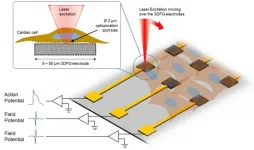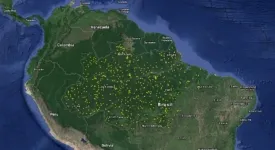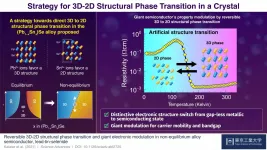Stellar feedback and an airborne observatory; scientists determine a nebula younger than believed
2021-04-13
(Press-News.org) In the southern sky, situated about 4,300 light years from Earth, lies RCW 120, an enormous glowing cloud of gas and dust. This cloud, known as an emission nebula, is formed of ionized gases and emits light at various wavelengths. An international team led by West Virginia University researchers studied RCW 120 to analyze the effects of stellar feedback, the process by which stars inject energy back into their environment. Their observations showed that stellar winds cause the region to expand rapidly, which enabled them to constrain the age of the region. These findings indicate that RCW 120 must be less than 150,000 years old, which is very young for such a nebula.
About seven light years from the center of RCW 120 lies the boundary of the cloud, where a plethora of stars are forming. How are all of these stars being formed? To answer that question, we need to dig deep into the origin of the nebula. RCW 120 has one young, massive star in its center, which generates powerful stellar winds. The stellar winds from this star are much like those from our own Sun, in that they throw material out from their surface into space. This stellar wind shocks and compresses the surrounding gas clouds. The energy that is being input into the nebula triggers the formation of new stars in the clouds, a process known as "positive feedback" because the presence of the massive central star has a positive effect on future star formation. The team, featuring WVU postdoctoral researcher Matteo Luisi, used SOFIA (the Stratospheric Observatory for Infrared Astronomy) to study the interactions of massive stars with their environment.
SOFIA is an airborne observatory consisting of an 8.8-foot (2.7-meter) telescope carried by a modified Boeing 747SP aircraft. SOFIA observes in the infrared regime of the electromagnetic spectrum, which is just beyond what humans can see. For observers on the ground, water vapor in the atmosphere blocks much of the light from space that infrared astronomers are interested in measuring. However, its cruising altitude of seven miles (13 km), puts SOFIA above most of the water vapor, allowing researchers to study star-forming regions in a way that would not be possible from the ground. Overnight, the in-flight observatory observes celestial magnetic fields, star-forming regions (like RCW 120), comets and nebulae. Thanks to the new upGREAT receiver that was installed in 2015, the airborne telescope can make more precise maps of large areas of the sky than ever before. The observations of RCW 120 are part of the SOFIA FEEDBACK survey, an international effort led by researchers Nicola Schneider at the University of Cologne and Alexander Tielens at the University of Maryland, which makes use of upGREAT to observe a multitude of star-forming regions.
The research team opted to observe the spectroscopic [CII] line with SOFIA, which is emitted from diffuse ionized carbon in the star-forming region. "The [CII] line is probably the best tracer of feedback on small scales, and--unlike infrared images--it gives us velocity information, meaning we can measure how the gas moves. The fact that we can now observe [CII] easily across large regions in the sky with upGREAT makes SOFIA a really powerful instrument to explore stellar feedback in more detail than was possible previously," says Matteo.
Using their [CII] observations from SOFIA, the research team found that RCW 120 is expanding at 33,000 mph (15 km/s), which is incredibly fast for a nebula. From this expansion speed, the team was able to put an age limit on the cloud and found that RCW 120 is much younger than previously believed. With the age estimate, they were able to infer the time it took for the star formation at the boundary of the nebula to kick in after the central star had been formed. These findings suggest that positive feedback processes occur on very short timescales and point to the idea that these mechanisms could be responsible for the high star formation rates that occurred during the early stages of the universe.
Looking forward, the team hopes to expand this type of analysis to the study of more star forming regions. Matteo says, "The other regions we are looking at with the FEEDBACK survey are in different stages of evolution, have different morphologies, and some have many high-mass stars in them, as opposed to only one in RCW 120. We can then use this information to determine what processes primarily drive triggered star formation and how feedback processes differ between various types of star-forming regions."
INFORMATION:
Matteo is a postdoctoral researcher in the West Virginia University Department of Physics and Astronomy and in the Center for Gravitational Waves and Cosmology. He studies how the most massive stars in our Galaxy interact with their environments. His collaborators on this project include researchers from West Virginia University, the Green Bank Observatory, the University of Cologne, the Max-Planck Institute for Radio Astronomy, Aix-Marseille University, Pennsylvania State University, the University of Maryland and Leiden University.
Full publication: https://advances.sciencemag.org/content/7/15/eabe9511
hmw/hal/ml/04/09/21
[Attachments] See images for this press release:

ELSE PRESS RELEASES FROM THIS DATE:
2021-04-13
Behind every heartbeat and brain signal is a massive orchestra of electrical activity. While current electrophysiology observation techniques have been mostly limited to extracellular recordings, a forward-thinking group of researchers from Carnegie Mellon University and Istituto Italiano di Tecnologia has identified a flexible, low-cost, and biocompatible platform for enabling richer intracellular recordings.
The group's unique "across the ocean" partnership started two years ago at the Bioelectronics Winter School (BioEl) with libations and a bar napkin sketch. It has evolved into research published today in Science ...
2021-04-13
Slow down. Baby on board.
So says UBC Okanagan researcher and Associate Professor of Mechanical Engineering Hadi Mohammadi. His new research, conducted in collaboration with Sharif University of Technology, determines that accelerating over speed bumps poses a danger for pregnant women and their fetuses.
"There is lots of research about the importance of movement for women during pregnancy," explains Mohammadi, who teaches in the School of Engineering. "Our latest research looked specifically at the impacts of sudden acceleration on a pregnant woman."
Using new modelling based on data from ...
2021-04-13
When the Webster-Kirkwood Times, a community newspaper in the greater St. Louis, Missouri area, had to endure layoffs and stop publishing its print edition -- due to a loss in revenue as a result of the COVID-19 pandemic -- its readers felt the loss and began supporting the newspaper in earnest.
"A lot of times people don't know what they've got until it's gone," said Jaime Mowers, editor-in-chief of the Webster-Kirkwood Times. "Now, there is such a newfound appreciation for the newspaper. It's amazing to have the community's support, knowing we are loved that much and appreciated enough to ...
2021-04-13
BUFFALO, N.Y. - Mindfulness is big business. Downloads of mindfulness apps generate billions of dollars annually in the U.S., and their popularity continues to rise. In addition to what individual practitioners might have on their phones, schools and prisons along with 1 in 5 employers currently offer some form of mindfulness training.
Mindfulness and meditation are associated with reducing stress and anxiety, while increasing emotional well-being. Plenty of scholarship supports these benefits. But how does mindfulness affect the range of human behaviors -- so-called prosocial behaviors -- that can potentially help or benefit other people? What happens when the research looks outwardly at social effects of mindfulness rather than inwardly at its personal effects?
It's ...
2021-04-13
Human screams signal more than fear and are more acoustically diverse than previously thought, according to a study published April 13th 2021 in the open-access journal PLOS Biology by Sascha Fru?hholz of the University of Zurich, and colleagues. Remarkably, non-alarming screams are perceived and processed by the brain more efficiently than alarming screams.
In nonhuman primates and other mammalian species, scream-like calls are frequently used as an alarm signal exclusively in negative contexts, such social conflicts or the presence of predators or other environmental threats. Humans are also assumed to use screams to signal danger and to scare predators. But humans scream not only when they are ...
2021-04-13
First study to examine suicides occurring around the world during the COVID-19 pandemic finds that - in high-income and upper-middle-income countries - suicide numbers have remained largely unchanged or have declined in the early months of the pandemic, compared with expected levels.
However, the authors stress that governments must remain vigilant as the longer-term mental health and economic effects of the pandemic unfold and be poised to respond if the situation changes.
Study looked at numbers of suicides in 21 countries between 1 April and 31 July 2020 and compared these with trends in the previous one to four years.
A new observational study ...
2021-04-13
Screaming can save lives. Non-human primates and other mammalian species frequently use scream-like calls when embroiled in social conflicts or to signal the presence of predators and other threats. While humans also scream to signal danger or communicate aggression, they scream when experiencing strong emotions such as despair or joy as well. However, past studies on this topic have largely focused on alarming fear screams.
Humans respond to positive screams more quickly and with higher sensitivity
In a new study, a team at the University of Zurich Department of Psychology led by Sascha Frühholz ...
2021-04-13
Living near a hazardous waste or Superfund site could cut your life short by about a year, reports Hanadi S. Rifai, John and Rebecca Moores Professor of Civil and Environmental Engineering at the University of Houston. The study, published in Nature Communications and based on evaluation of 65,226 census tracts from the 2018 Census, is the first nationwide review of all hazardous waste sites and not just the 1,300 sites on the national priority list managed by the federal government.
The analysis shows a decrease of more than two months in life expectancy for those living near a Superfund site. When coupled with high disadvantage of sociodemographic factors like age, sex, marital status and income, the decrease could be nearly 15 months, ...
2021-04-13
A group of researchers led by Brazilians has used an innovative model to map gaps in the Amazon rainforest and identify factors that contribute to tree mortality. Water stress, soil fertility, and anthropic forest degradation have the most influence on gap dynamics in the world's largest and most biodiverse tropical rainforest, according to an article on the study published in Scientific Reports.
Forest gaps are most frequent in the areas with the highest levels of soil fertility, possibly because the abundance of organic material drives faster tree growth and shorter life cycles.
The main method of data collection ...
2021-04-13
The electronic properties of solid materials are highly dependent on crystal structures and their dimensionalities (i.e., whether the crystals have predominantly 2D or 3D structures). As Professor Takayoshi Katase of Tokyo Institute of Technology notes, this fact has an important corollary: "If the crystal structure dimensionality can be switched reversibly in the same material, a drastic property change may be controllable." This insight led Prof. Katase and his research team at Tokyo Institute of Technology, in partnership with collaborators at Osaka University and National Institute for Materials Science, to embark on research into the possibility of switching the crystal structure dimensionality of a lead-tin-selenide alloy semiconductor. Their results appear in a paper published ...
LAST 30 PRESS RELEASES:
[Press-News.org] Stellar feedback and an airborne observatory; scientists determine a nebula younger than believed






